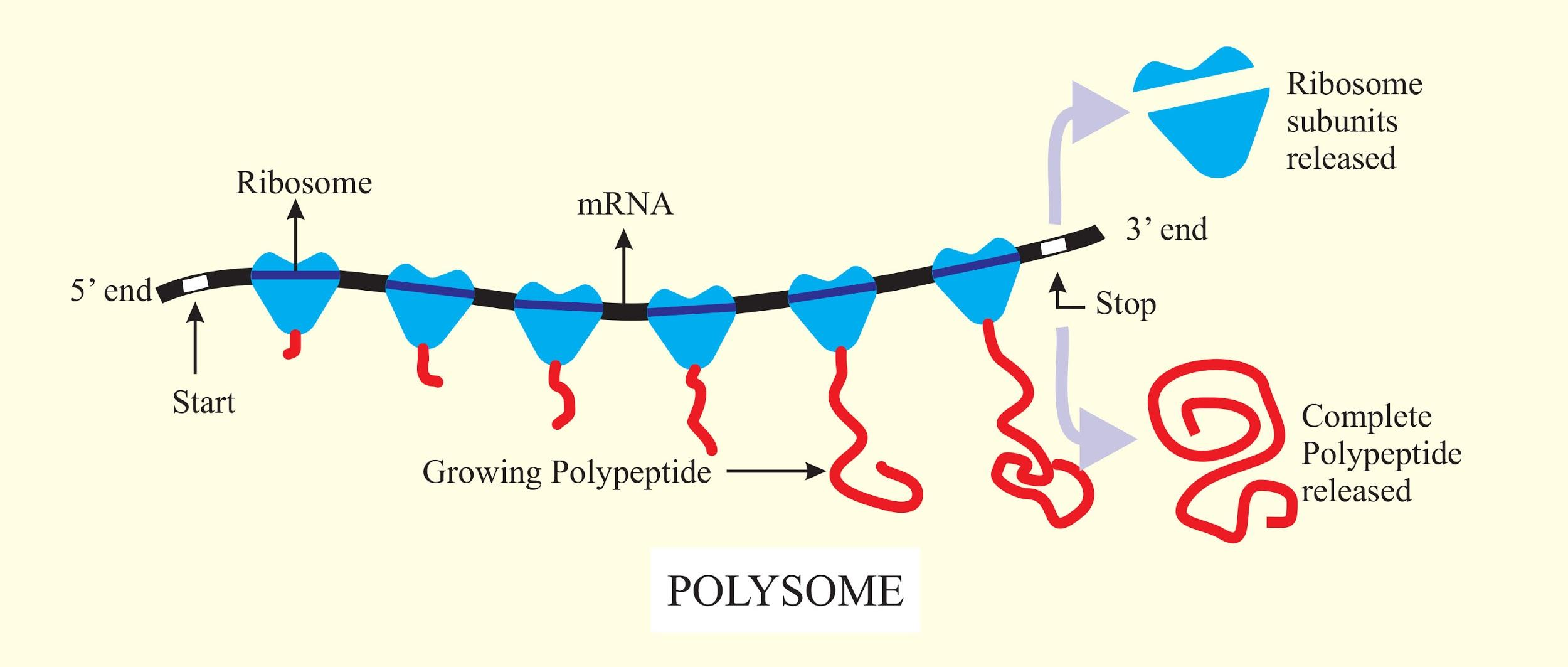
What is the function of a polysome?
Answer
477.6k+ views
Hint: Polysome is a thread-like structure that is a group of ribosomes that are bound to a messenger RNA molecule. It constitutes a complex of an mRNA and ribosomes which help to translate mRNA into polypeptides.
Complete step by step answer:
Ribosomes can translate mRNA and form polysomes. If more than one ribosome translates an mRNA it forms many polypeptides from a single mRNA. When the ribosomes and elongation factor synthesize the encoded polypeptide, polysomes are formed. It is created by the coding region of mRNA which is moved by multiple ribosomes. This ability of multiple ribosomes in the functioning of an mRNA explains the abundance of mRNA in the cells. The structure of polyribosomes is different in prokaryotic polysomes, eukaryotic polysomes, and membrane-bound polysomes. The level of gene expression through a technique is measured by polysome activity and is known as polysomal profiling. Polysomal profiling is used to arrest translation and sucrose gradient for the separation of resulting cells to be extracted by centrifugation. The increase in the number of ribosomes is associated with the corresponding mRNA. It is applied to cultured cells and tissues which track the translational status of identified mRNA and measure ribosome density.
Additional information:
In prokaryotic cells, the bacterial polysomes are in the form of double row structures and the ribosome is contacting each other within smaller subunits. In eukaryotic cells, the densely packed 3D helices and double row polysomes which are planar are found, which are similar to that of prokaryotic polysomes. They are bound to the membrane by a two-dimensional space and the restriction of inter ribosomal contacts that arrange ribosomes along with the mRNA form a smooth pathway. The polysomal profiling is used to investigate the effect of vesicular stomatitis virus. It shows that the host mRNAs are outcompeted by the viral mRNA which decreases the translation of host mRNA with increasing in the translation of viral mRNA.

Note: Ribosomes are present in eukaryotic cells and prokaryotic cells and can be found in human beings. They are free-floating in the cytoplasm and are found attached to the endoplasmic reticulum. They are transported inside the nucleolus as the raw materials are produced outside the nucleus.
Complete step by step answer:
Ribosomes can translate mRNA and form polysomes. If more than one ribosome translates an mRNA it forms many polypeptides from a single mRNA. When the ribosomes and elongation factor synthesize the encoded polypeptide, polysomes are formed. It is created by the coding region of mRNA which is moved by multiple ribosomes. This ability of multiple ribosomes in the functioning of an mRNA explains the abundance of mRNA in the cells. The structure of polyribosomes is different in prokaryotic polysomes, eukaryotic polysomes, and membrane-bound polysomes. The level of gene expression through a technique is measured by polysome activity and is known as polysomal profiling. Polysomal profiling is used to arrest translation and sucrose gradient for the separation of resulting cells to be extracted by centrifugation. The increase in the number of ribosomes is associated with the corresponding mRNA. It is applied to cultured cells and tissues which track the translational status of identified mRNA and measure ribosome density.
Additional information:
In prokaryotic cells, the bacterial polysomes are in the form of double row structures and the ribosome is contacting each other within smaller subunits. In eukaryotic cells, the densely packed 3D helices and double row polysomes which are planar are found, which are similar to that of prokaryotic polysomes. They are bound to the membrane by a two-dimensional space and the restriction of inter ribosomal contacts that arrange ribosomes along with the mRNA form a smooth pathway. The polysomal profiling is used to investigate the effect of vesicular stomatitis virus. It shows that the host mRNAs are outcompeted by the viral mRNA which decreases the translation of host mRNA with increasing in the translation of viral mRNA.

Note: Ribosomes are present in eukaryotic cells and prokaryotic cells and can be found in human beings. They are free-floating in the cytoplasm and are found attached to the endoplasmic reticulum. They are transported inside the nucleolus as the raw materials are produced outside the nucleus.
Recently Updated Pages
Express the following as a fraction and simplify a class 7 maths CBSE

The length and width of a rectangle are in ratio of class 7 maths CBSE

The ratio of the income to the expenditure of a family class 7 maths CBSE

How do you write 025 million in scientific notatio class 7 maths CBSE

How do you convert 295 meters per second to kilometers class 7 maths CBSE

Write the following in Roman numerals 25819 class 7 maths CBSE

Trending doubts
Give 10 examples of unisexual and bisexual flowers

Draw a labelled sketch of the human eye class 12 physics CBSE

Differentiate between homogeneous and heterogeneous class 12 chemistry CBSE

Differentiate between insitu conservation and exsitu class 12 biology CBSE

What are the major means of transport Explain each class 12 social science CBSE

Franz thinks Will they make them sing in German even class 12 english CBSE




